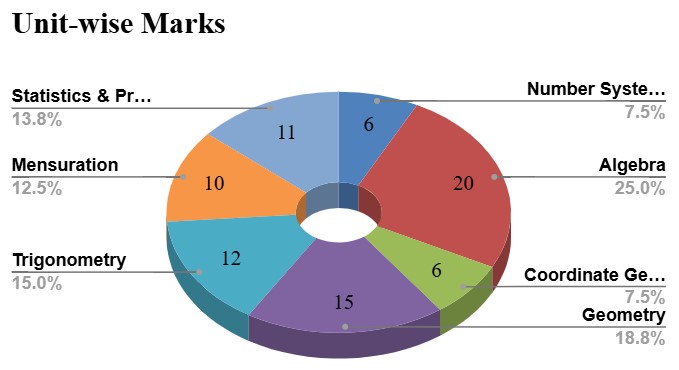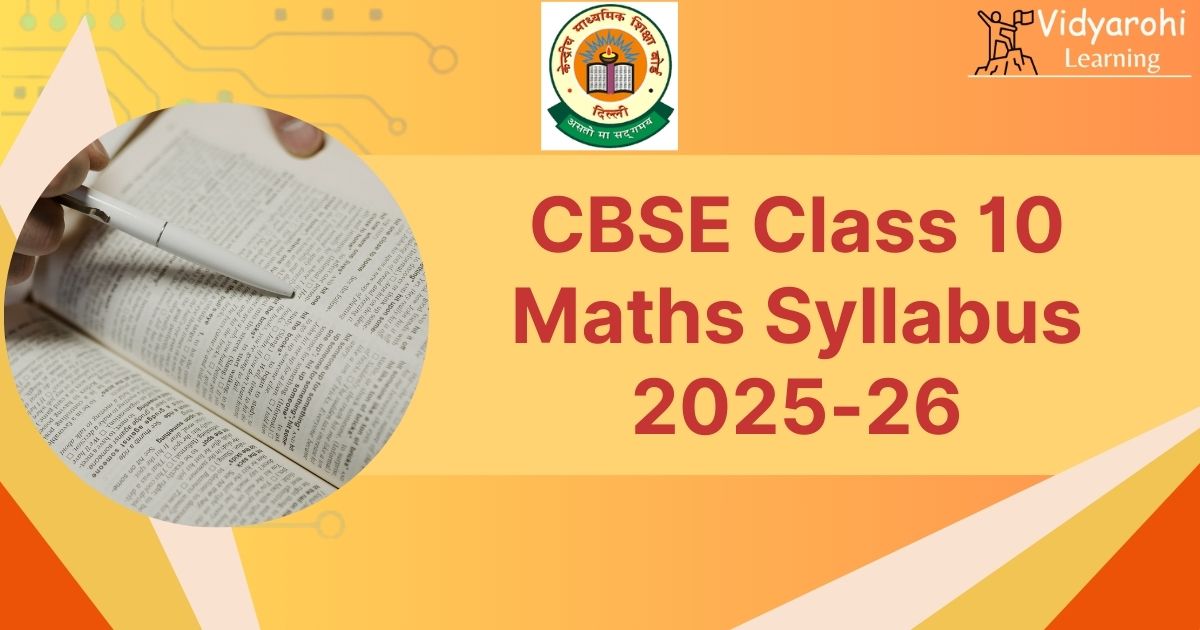CBSE Class 10 Maths Syllabus 2025-26: The Central Board of Secondary Education (CBSE) has released the Class 10 Maths Syllabus for 2025-26. This syllabus gives the full list of chapters and topics that students need to study in Mathematics. It also explains the exam pattern and how marks will be given. Maths is an important subject for Class 10 students because it builds a strong base for higher studies and competitive exams like JEE, NDA, CA Foundation and CUET. By following the updated syllabus, students can prepare better for their board exams and score good marks.
This resource will be helpful for students to understand the scope of the curriculum and plan their studies accordingly. The CBSE Maths Syllabus is designed to:
- Provide a strong academic foundation.
- Build a strong foundation for national-level competitive exams.
- Encourage conceptual understanding, application, and analysis rather than rote learning.
CBSE 10th Maths Syllabus 2025-26 Download PDF
The CBSE Class 10 Maths Syllabus is designed to give students a strong understanding of Mathematics and prepare them for higher studies and competitive exams. Knowing the syllabus well and studying regularly are important to score good marks. Below, students can find the direct link to download the CBSE Class 10 Maths Syllabus PDF.
CBSE 10th Maths Syllabus 2025-26 Download PDF
The CBSE Class 10 Maths Syllabus for 2025-26 is designed to promote conceptual clarity, analytical skills, and real-life problem-solving abilities. Start early, be consistent, and focus on understanding over memorisation. Below, students can check the CBSE Class 10 Maths Syllabus, including unit-wise weightage and other useful data insights.
Unit I: Number Systems
- Real Numbers: Fundamental Theorem of Arithmetic - statements after reviewing work done earlier and after illustrating and motivating through examples. Proofs of irrationality of √2, √3, √5
Unit II: Algebra
- Polynomials: Zeros of a polynomial, Relationship between zeros and coefficients of quadratic polynomials.
- Pair Of Linear Equations In Two Variables: Pair of linear equations in two variables and graphical method of their solution, consistency/inconsistency. Algebraic conditions for number of solutions. Solution of a pair of linear equations in two variables algebraically - by substitution, by elimination. Simple situational problems.
- Quadratic Equations: Standard form of a quadratic equation, Solutions of quadratic equations (only real roots) by factorization, and by using quadratic formula. Relationship between discriminant and nature of roots. Situational problems based on quadratic equations related to day-to-day activities to be incorporated
- Arithmetic Progressions: Motivation for studying Arithmetic Progression, Derivation of the nth term and sum of the first n terms of AP and their application in solving daily life problems.
Unit III: Coordinate Geometry
- Concepts of coordinate geometry. Distance formula. Section formula (internal division).
Unit IV: Geometry
- Triangles: Definitions, examples, counter examples of similar triangles.
- (Prove) If a line is drawn parallel to one side of a triangle to intersect the other two sides in distinct points, the other two sides are divided in the same ratio.
- State (without proof) If a line divides two sides of a triangle in the same ratio, the line is parallel to the third side.
- State (without proof) If in two triangles, the corresponding angles are equal, their corresponding sides are proportional and the triangles are similar.
- State (without proof) If the corresponding sides of two triangles are proportional, their corresponding angles are equal and the two triangles are similar.
- State (without proof) If one angle of a triangle is equal to one angle of another triangle and the sides including these angles are proportional, the two triangles are similar.
- Circles: Tangent to a circle at point of contact.
- (Prove) The tangent at any point of a circle is perpendicular to the radius through the point of contact.
- (Prove) The lengths of tangents drawn from an external point to a circle are equal.
Unit V: Trigonometry
- Introduction To Trigonometry: Trigonometric ratios of an acute angle of a right-angled triangle. Proof of their existence (well defined). Motivate the ratios whichever are defined at 0° and 90°. Values of the trigonometric ratios of 30°, 45° and 60°. Relationships between the ratios.
- Trigonometric Identities: Proof and applications of the identity sin2A + cos2A = 1. Only simple identities to be given.
- Heights And Distances: Angle of elevation, Angle of Depression. Simple problems on heights and distances. Problems should not involve more than two right triangles. Angles of elevation/depression should be only 30°, 45°, and 60°.
Unit VI: Mensuration
- Areas Related To Circles: Area of sectors and segments of a circle. Problems based on areas and perimeter/circumference of the above said plane figures. (In calculating area of segment of a circle, problems should be restricted to central angle of 60°, 90° and 120° only.
- Surface Areas And Volumes: Surface areas and volumes of combinations of any two of the following: cubes, cuboids, spheres, hemispheres and right circular cylinders/cones
Unit VII: Statistics & Probability
- Statistics: Mean, median and mode of grouped data (bimodal situation to be avoided).
- Probability: Classical definition of probability. Simple problems on finding the probability of an event.
CBSE Class 10 Mathematics Unit-wise Weightage
The CBSE Class 10 Mathematics syllabus is divided into several units, each carrying a specific weightage in the board exam. Understanding the unit-wise weightage helps students prioritise their preparation. The Calculus unit, being the most important, has the highest weightage of 35 marks. Below, we are providing the CBSE 10th Math Unit-wise weightage for your reference. This distribution helps students understand where to focus more time and effort for better results in the final exam.
| Unit No. | Unit Name | Marks |
| I | Number Systems | 6 |
| II | Algebra | 20 |
| III | Coordinate Geometry | 6 |
| IV | Geometry | 15 |
| V | Trigonometry | 12 |
| VI | Mensuration | 10 |
| VII | Statistics & Probability | 11 |
| Total | 80 | |
| Internal Assessment | 20 |

Internal Assessment is further divided into three components, i.e., Periodic Tests, Project work and Portfolio, whose breakup is given below:
| Component | Marks |
| Pen Paper Test and Multiple Assessment (5+5) | 10 |
| Portfolio | 5 |
| Lab Practical (Lab activities to be done from the prescribed books) | 5 |
| Total | 20 |

Tips for Covering the CBSE Class 10 Maths Syllabus Effectively
Understand the Maths Syllabus Thoroughly: Before you begin your preparation, carefully go through the entire Maths Syllabus and marking scheme provided by CBSE. This helps you focus on the most important topics.
- Create a Study Plan: Divide the Maths Syllabus into manageable sections and create a realistic study plan. Allocate time for each subject based on its difficulty level and your comfort.
- Use NCERT Books: CBSE recommends NCERT textbooks for exam preparation, as most of the questions are based on these books. Read the chapters thoroughly and practice the questions at the end.
- Create Revision Notes: Create concise revision notes with essential formulas, concepts, and important points for quick last-minute review.
- Solve Sample Papers and Previous Years Papers: CBSE releases sample question papers every year to help students get familiar with the exam pattern. Solve as many sample papers and previous year's question papers as possible.
- Focus on Practical Subjects: For subjects with practical components, ensure you spend sufficient time in the lab and understand the experiments thoroughly.
- Revise Regularly: Keep revising the concepts regularly, and make sure to cover all the important topics at least two months before the exams.
CBSE Class 10 Mathematics Exam Pattern 2025
The CBSE Class 10 Mathematics board exam consists of a theory paper of 80 marks, with an internal assessment of 20 marks. The question paper is divided into five different sections:
| Section | Question Type | Number of Questions | Marks |
| A | Multiple Choice Questions & Assertion and Reason Questions (1 mark) | 20 | 20 |
| B | Very Short Answer (2 mark) | 5 | 10 |
| C | Short Answer (3 marks) | 6 | 18 |
| D | Long Answer (5 marks) | 4 | 20 |
| E | Case Study-Based Questions (3 marks) | 3 | 12 |
| Total | 38 | 80 | |
Check the latest and detailed CBES Class 10th Maths Exam Pattern 2025 with Marking Scheme.


